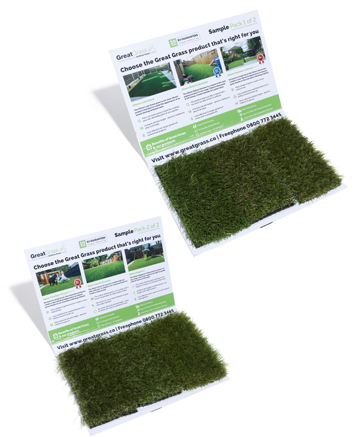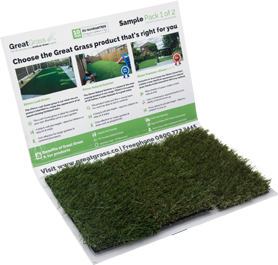Artificial grass is becoming more and more popular with each passing year. Once considered nothing more than a poor man’s substitute for a natural lawn, the material has since earned the respect and preference of many home-owners the world over, with its unique combination of low maintenance requirements, durability and visual appeal. As a result, many homes the world over currently boast synthetic grass where there once was a real lawn, and the material is used in place of real grass in a growing number of sports pitches as well.
However, as the popularity of this type of floor covering grows, so too do the questions and doubts from potential buyers become more frequent. Home-owners and sports facility managers looking to purchase synthetic lawns tend to not know much more than the absolute basics about this material, and as such, companies such as GreatGrass often find themselves having to answer all manner of questions on the part of interested customers.
One such question, and one which frequently occurs when buyers are slightly more informed than usual, has to do with the best base materials for artificial grass. The base layer is an essential part of any synthetic grass carpet, as it provides a hard surface upon which the grass is laid; as such, it is important that home-owners know how to choose the right material to ensure this goal is achieved. Choosing the wrong base material could potentially cause areas of the synthetic lawn to sag or damage over time, and as such, this is an area which should be given some attention.
It is in that spirit that the lines below attempt to offer some suggestions as to what we at GreatGrass believe to be the best base materials for artificial grass. As synthetic lawn specialists, we often find ourselves having to elucidate our customers on this topic, and as such, we thought we might as well share our knowledge in a blog post. That knowledge is relayed in the paragraphs below.
Tarmac
Tarmac is perhaps the most popular base material for artificial grass. A vast majority of artificial lawns are built on top of this material, which possesses ideal characteristics to serve this function.
The main advantage which makes tarmac one of the best base materials for artificial grass is the fact that it is, at once, hard and porous, combining the two most desirable characteristics in a material meant to carry out this type of function. Hardness is, obviously, important to ensure the artificial grass is laid on top of something solid, which will not give in or sag; however, porosity is arguably just as important, as a porous base layer facilitates natural drainage of any moisture or liquids from the synthetic grass carpet. This, in turn, circumvents the need for special drainage systems to be installed, resulting in less expenditure for the home-owner.
As such, the fact that tarmac naturally boasts both these features puts it at an advantage when compared to the other common materials normally used as bases for artificial grass, and making it the favourite for installation specialists and home-owners alike.
Asphalt
While tarmac is the preferred material over which to lay artificial grass for most home-owners, it is, however, far from the only type of surface which can be used for this purpose; in situations where this material is not available, Installation specialists such as the ones working for GreatGrass will also happily use one or two other alternatives to achieve the same result.
One such alternative is asphalt, which, as it turns out, as just as suited for serving as a base to artificial grass as it is for paving roads. While not as ideally suited for this function as tarmac is, asphalt is a perfectly acceptable alternative, being just as firm and consistent as its counterpart, if not quite as porous. Porosity is, however, the only thing separating it from tarmac, as in every other regard asphalt performs just as well as a base upon which to lay synthetic grass carpets. As such, it is not all that surprising that many installation professionals will happily use it as a base for artificial grass, should tarmac not be readily available.
Concrete
The other common alternative to tarmac as a base layer for synthetic grass is concrete, another material normally used for a different type of application. However, like asphalt, this surface proves itself surprisingly adept as the base for a synthetic grass carpet, providing firmness and hardness even beyond that of its two direct ‘competitors.’
There is, however, one distinct disadvantage preventing concrete from occupying quite as high a place as said competitors, namely the fact that it does not at all allow for drainage. What this means, in practical terms, is that any customer who chooses to use this material as the base layer for artificial grass will have to incur the extra expenditure of installing a man-made drainage system under the layer, to account for this lack of porosity.
Even still, customers who can afford to field this additional cost will find concrete to be an extra-hard base layer for their synthetic lawns, ensuring there is no risk of them becoming uneven, lumpy or sagged over time. This characteristic is often enough to cause home-owners and sports field managers to overlook the need for extra drainage and go for concrete anyway, but is still not enough to make it rank any higher than number three on the list of best base materials for artificial grass.
Even still, it is clear that there are a variety of different surfaces suitable for use as a base for a synthetic lawn. As stated above, tarmac is favourite, and concrete lags slightly behind due to its additional requirements, but both these two materials and asphalt will carry out this function to a more than acceptable standard. Customers wondering what the best base materials for artificial grass might be should, therefore, be aware that the three detailed in this article are the ones to go for, above all others!


